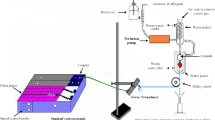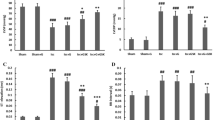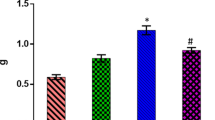Abstract
Ischemic–reperfusion (I/R) is a major event in the pathogenesis of ischemic heart disease that leads to higher rate of mortality. The study has been designed to investigate the therapeutic potential and molecular mechanism of vitamin P and digoxin in I/R-induced myocardial infarction in isolated rat heart preparation by using Langendorff apparatus. The animals were treated with vitamin P (50 and 100 mg/kg; p.o.) and digoxin (500 μg/kg) for 5 consecutive days. Digoxin served as a positive control in the present study. On the sixth day, the heart was harvested and induced to 30 min of global ischemia followed by 120 min of reperfusion using Langendorff apparatus. The coronary effluent was collected at different time intervals (i.e. basal, 1, 15, 30, 45, 60 and 120 min.) for the assessment of myocardial contractility function. In addition, creatine kinase–M and B subunits (CK-MB), lactate dehydrogenase (LDH1) and Na+-K+-ATPase activity along with oxidative tissue biomarkers (i.e. thio-barbituric acid reactive substances (TBARS) and reduced glutathione (GSH)) changes were estimated. The I/R of myocardium produced decrease in coronary flow rate; increase in CK-MB, LDH1 and Na+-K+-ATPase activity along with increase in TBARS and decrease in GSH levels as compared to normal group. The treatment with vitamin P (100 mg/kg) and digoxin (500 μg/kg) have produced a significant (p < 0.05) ameliorative effect against I/R induced above functional, metabolic and tissue biomarkers changes. Vitamin P has an ameliorative potential against I/R induced myocardial functional changes. It may be due to its free radical scavenging and anti-infarct property via inhibition of Na+-K+-ATPase activity. Therefore, it can be used as a potential therapeutic medicine for the management of cardiovascular disorders.


Similar content being viewed by others
References
Almeida JS, Benvegnú DM, Boufleur N, Reckziegel P, Barcelos RC, Coradini K, de Carvalho LM, Bürger ME, Beck RC (2012) Hydrogels containing rutin intended for cutaneous administration: efficacy in wound healing in rats. Drug Dev Ind Pharm 38:792–799
Annapurna A, Reddy CS, Akondi RB, Rao SR (2009) Cardioprotective actions of two bioflavonoids, quercetin and rutin, in experimental myocardial infarction in both normal and streptozotocin-induced type I diabetic rats. J Pharm Pharmacol 61:1365–1374
Arslan F, Lai RC, Smeets MB, Akeroyd L, Choo A, Aguor EN, Timmers L, van Rijen HV, Doevendans PA, Pasterkamp G, Lim SK, de Kleijn DP (2013) Mesenchymal stem cell-derived exosomes increase ATP levels, decrease oxidative stress and activate PI3K/Akt pathway to enhance myocardial viability and prevent adverse remodeling after myocardial ischemia/reperfusion injury. Stem Cell Res 10:301–312
Aruna R, Geetha A, Suguna P, Suganya V (2014) Rutin rich Emblica officinalis Geart. fruit extract ameliorates inflammation in the pancreas of rats subjected to alcohol and cerulein administration. J Complement Integr Med 11:9–18
Aydin MS, Caliskan A, Kocarslan A, Koçarslan S, Yildiz A, Günay S, Savik E, Hazar A, Yalcin F (2014) Intraperitoneal curcumin decreased lung, renal and heart injury in abdominal aorta ischemia/reperfusion model in rat. Int J Surg 12:601–605
Bell RM, Mocanu MM, Yellon DM (2011) Retrograde heart perfusion: the Langendorff technique of isolated heart perfusion. J Mol Cell Cardiol 50:940–950
Beutler E, Duron O, Kelly BM (1963) Improved method for the determination of blood glutathione. J Lab Clin Med 61:882–888
Bhandary B, Piao CS, Kim DS, Lee GH, Chae SW, Kim HR, Chae HJ (2012) The protective effect of rutin against ischemia/reperfusion-associated hemodynamic alteration through antioxidant activity. Arch Pharm Res 35:1091–1097
Bruynzeel AM, Niessen HW, Bronzwaer JG, van der Hoeven JJ, Berkhof J, Bast A, van der Vijgh WJ, van Groeningen CJ (2007) The effect of monohydroxyethylrutoside on doxorubicin-induced cardiotoxicity in patients treated for metastatic cancer in a phase II study. Br J Cancer 97:1084–1089
Bueno-Orovio A, Sanchez C, Pueyo E, Rodriguez B (2014) Na/K pump regulation of cardiac repolarization: insights from a systems biology approach. Pflugers Arch 466:183–193
Campia I, Sala V, Kopecka J, Leo C, Mitro N, Costamagna C, Caruso D, Pescarmona G, Crepaldi T, Ghigo D, Bosia A, Riganti C (2012) Digoxin and ouabain induce the efflux of cholesterol via liver X receptor signalling and the synthesis of ATP in cardiomyocytes. Biochem J 447:301–311
Cha J, Roomi MW, Ivanov V, Kalinovsky T, Niedzwiecki A, Rath M (2013) Ascorbate supplementation inhibits growth and metastasis of B16FO melanoma and 4 T1 breast cancer cells in vitamin C-deficient mice. Int J Oncol 42:55–64
Chen H, Miao Q, Geng M, Liu J, Hu Y, Tian L, Pan J, Yang Y (2013) Anti-tumor effect of rutin on human neuroblastoma cell lines through inducing G2/M cell cycle arrest and promoting apoptosis. Scientific World Journal 2013:269165
Cheung JY, Zhang XQ, Song J, Gao E, Chan TO, Rabinowitz JE, Koch WJ, Feldman AM, Wang J (2013) Coordinated regulation of cardiac Na(+)/Ca(2+) exchanger and Na (+)-K(+)-ATPase by phospholemman (FXYD1). Adv Exp Med Biol 961:175–190
Chua LS (2013) A review on plant-based rutin extraction methods and its pharmacological activities. J Ethnopharmacol 150:805–817
Correll RN, Eder P, Burr AR, Despa S, Davis J, Bers DM, Molkentin JD (2014) Overexpression of the Na+/K+-ATPase α2 but not α1 isoform attenuates pathological cardiac hypertrophy and remodeling. Circ Res 114:249–256
Dar MA, Tabassum N (2012) Rutin- potent natural thrombolytic agent. Int Curr Pharm J 1:431–435
De Celle T, Heeringa P, Strzelecka AE, Bast A, Smits JF, Janssen BJ (2004) Sustained protective effects of 7-monohydroxyethylrutoside in an in vivo model of cardiac ischemia-reperfusion. Eur J Pharmacol 494:205–212
Dhanya R, Arun KB, Syama HP, Nisha P, Sundaresan A, Santhosh Kumar TR, Jayamurthy P (2014) Rutin and quercetin enhance glucose uptake in L6 myotubes under oxidative stress induced by tertiary butyl hydrogen peroxide. Food Chem 158:546–554
Diwan V, Kant R, Jaggi AS, Singh N, Singh D (2008) Signal mechanism activated by erythropoietin preconditioning and remote renal preconditioning-induced cardioprotection. Mol Cell Biochem 315:195–201
Ertracht O, Malka A, Atar S, Binah O (2014) The mitochondria as a target for cardioprotection in acute myocardial ischemia. Pharmacol Ther 142:33–40
Fishbein MC, Maclean D, Moroko PR (1978) The histopathologic evolution of myocardial infarction. Chest 73:843–849
Fontana JM, Burlaka I, Khodus G, Brismar H, Aperia A (2013) Calcium oscillations triggered by cardiotonic steroids. FEBS J 280:5450–5455
Garber GC, Miller RC (1983) Revision of semidine HCl standard method for inorganic phosphorus. Clin Chem 29:184–188
Gunduz D, Kasseckert SA, Härtel FV, Aslam M, Abdallah Y, Schäfer M, Piper HM, Noll T, Schäfer C (2006) Accumulation of extracellular ATP protects against acute reperfusion injury in rat heart endothelial cells. Cardiovasc Res 71:764–773
Headrick JP, Peart J, Hack B, Garnham B, Matherne GP (2001) 5′-Adenosine monophosphate and adenosine metabolism, and adenosine responses in mouse, rat and guinea pig heart. Comp Biochem Physiol A Mol Integr Physiol 130:615–631
Jang JW, Lee JK, Hur H, Kim TW, Joo SP, Piao MS (2014) Rutin improves functional outcome via reducing the elevated matrix metalloproteinase-9 level in a photothrombotic focal ischemic model of rats. J Neurol Sci 339:75–80
Laemmel E, Stücker O, Pons C, Duverger JP, Dedieu F, Leutenegger E (1998) Microcirculatory consequences of a venous striction in the rat. Effect of a coumarine-rutine association. J Mal Vasc 23:176–182
Langendorff O (1895) Untersuchungen amuber lebenderer saugethierherzen. Pfluger Arch Gesmate Physiol 61:291–332
Li M, Jiang Y, Jing W, Sun B, Miao C, Ren L (2013) Quercetin provides greater cardioprotective effect than its glycoside derivative rutin on isoproterenol-induced cardiac fibrosis in the rat. Can J Physiol Pharmacol 91:951–959
Li Q, Pogwizd SM, Prabhu SD, Zhou L (2014) Inhibiting Na+/k+-ATPase can impair mitochondrial energetics and induce abnormal Ca2+ cycling and automaticity in Guinea pig cardiomyocytes. PLoS One 9:e93928
Liu CC, Fry NA, Hamilton EJ, Chia KK, Garcia A, Karimi Galougahi K, Figtree GA, Clarke RJ, Bundgaard H, Rasmussen HH (2013) Redox-dependent regulation of the Na+-K+ pump: new twists to an old target for treatment of heart failure. J Mol Cell Cardiol 61:94–101
Madhani M, Hall AR, Cuello F, Charles RL, Burgoyne JR, Fuller W, Hobbs AJ, Shattock MJ, Eaton P (2010) Phospholemman Ser69 phosphorylation contributes to sildenafil-induced cardioprotection against reperfusion injury. Am J Physiol Heart Circ Physiol 299:H827–H836
Morling JR, Yeoh SE, Kolbach DN (2013) Rutosides for treatment of post-thrombotic syndrome. Cochrane Database Syst Rev 4, CD005625
Muszbek L (1997) A highly sensitive method for the measurement of the ATP-ase activity. Anal Biochem 77:286–288
Niehaus W, Samuelsson B (1968) Formation of malonaldehyde from phospholipid arachidonate during microsomal lipid peroxidation. Eur J Biochem 6:126–130
Oria RB, Costa CM, Santos Tde J, Vieira CM (2003) Pharmacological, morphological and behavioral analysis of motor impairment in experimentally vitamin C deficient guinea pigs. Arq Neuropsiquiatr 61:25–33
Park SE, Sapkota K, Choi JH, Kim MK, Kim YH, Kim KM, Kim KJ, Oh HN, Kim SJ, Kim S (2014) Rutin from Dendropanax morbifera Leveille protects human dopaminergic cells against rotenone induced cell injury through inhibiting JNK and p38 MAPK signaling. Neurochem Res 39:707–718
Qu J, Zhou Q, Du Y, Zhang W, Bai M, Zhang Z, Xi Y, Li Z, Miao J (2014) Rutin protects against cognitive deficits and brain damage in rats with chronic cerebral hypoperfusion. Br J Pharmacol 171:3702–3715
Rashed KN, Ćirić A, Glamočlija J, Calhelha RC, Ferreira IC, Soković M (2013) Antimicrobial activity, growth inhibition of human tumour cell lines, and phytochemical characterization of the hydromethanolic extract obtained from Sapindus saponaria L. aerial parts. Biomed Res Int 2013:659183
Santel T, Pflug G, Hemdan NY, Schäfer A, Hollenbach M, Buchold M, Hintersdorf A, Lindner I, Otto A, Bigl M, Oerlecke I, Hutschenreuther A, Sack U, Huse K, Groth M, Birkemeyer C, Schellenberger W, Gebhardt R, Platzer M, Weiss T, Vijayalakshmi MA, Krüger M, Birkenmeier G (2008) Curcumin inhibits glyoxalase 1: a possible link to its anti-inflammatory and anti-tumor activity. PLoS One 3:e3508
Savvatis K, Westermann D, Schultheiss HP, Tschope C (2010) Kinins in cardiac inflammation and regeneration: insights from ischemic and diabetic cardiomyopathy. Neuropeptides 44:119–125
Scallon C, Bell-Syer SE, Aziz Z (2013) Flavonoids for treating venous leg ulcers. Cochrane Database Syst Rev 5:CD006477
Schulze K, Duschek C, Lasley RD (1985) Bunger R (2007) Adenosine enhances cytosolic phosphorylation potential and ventricular contractility in stunned guinea pig heart: receptor-mediated and metabolic protection. J Appl Physiol 102:1202–1213
See Hoe LE, Schilling JM, Tarbit E, Kiessling CJ, Busija AR, Niesman IR, Du Toit E, Ashton KJ, Roth DM, Headrick JP, Patel HH, Peart JN (2014) Sarcolemmal cholesterol and caveolin-3 dependence of cardiac function, ischemic tolerance, and opioidergic cardioprotection. Am J Physiol Heart Circ Physiol 307:H895–H903
Shen M, Wu RX, Zhao L, Li J, Guo HT, Fan R, Cui Y, Wang YM, Yue SQ, Pei JM (2012) Resveratrol attenuates ischemia/reperfusion injury in neonatal cardiomyocytes and its underlying mechanism. PLoS One 7:e51223
Stanely Mainzen Prince P, Karthick M (2007) Preventive effect of rutin on lipids, lipoproteins, and ATPases in normal and isoproterenol-induced myocardial infarction in rats. J Biochem Mol Toxicol 21:1–6
Takata K, Tomiyama Y, Tanaka K, Oshita S (2013) Cardioprotective effects of hyperkalemia during simulated ischemia/reperfusion in neonatal rat cardiomyocytes-Preservation of Na(+)/K(+)-ATPase activity. J Med Invest 60:66–76
Takawale A, Fan D, Basu R, Shen M, Parajuli N, Wang W, Wang X, Oudit GY, Kassiri Z (2014) Myocardial recovery from ischemia-reperfusion is compromised in the absence of tissue inhibitor of metalloproteinase 4. Circ Heart Fail 7:652–662
Vissers MC, Bozonet SM, Pearson JF, Braithwaite LJ (2011) Dietary ascorbate intake affects steady state tissue concentrations in vitamin C-deficient mice: tissue deficiency after suboptimal intake and superior bioavailability from a food source (kiwifruit). Am J Clin Nutr 93:292–301
Wang X, Xiong M, Zeng Y, Sun X, Gong T, Zhang Z (2014) Mechanistic studies of a novel mycophenolic acid-glucosamine conjugate that attenuates renal ischemia/reperfusion injury in rat. Mol Pharm 11:3503–3514
Webster KA (2012) Mitochondrial membrane permeabilization and cell death during myocardial infarction: roles of calcium and reactive oxygen species. Future Cardiol 8:863–884
Wu ZQ, Li M, Chen J, Chi ZQ, Liu JG (2006) Involvement of cAMP/cAMP-dependent protein kinase signaling pathway in regulation of Na+, K + -ATPase upon activation of opioid receptors by morphine. Mol Pharmacol 69:866–876
Xie H, Zhang J, Zhu J, Liu LX, Rebecchi M, Hu SM, Wang C (2014) Sevoflurane post-conditioning protects isolated rat hearts against ischemia-reperfusion injury via activation of the ERK1/2 pathway. Acta Pharmacol Sin 35:1504–1513
Yeh CH, Yang JJ, Yang ML, Li YC, Kuan YH (2014) Rutin decreases lipopolysaccharide-induced acute lung injury via inhibition of oxidative stress and the MAPK-NF-κB pathway. Free Radic Biol Med 69:249–257
Acknowledgments
The authors are thankful to Akal Toxicology Research Centre, a unit of Akal College of Pharmacy and Technical Education, Mastuana Sahib, Sangrur-148001, Punjab (India), for supporting this study and providing technical facilities for this work.
Conflict of interest
The authors declare that they have no conflict of interest.
Ethical approval
All procedures performed in studies involving animals were in accordance with the ethical standards of the Institutional Animal Ethics Committee (IAEC, no.: ATRC/16/13; Dated: 16.11.2013) and the care of the animals was taken as per the guidelines of the Committee for the Purpose of Control and Supervision of Experiments on Animals (CPCSEA), Ministry of Environmental and Forest, Government of India (Reg. no. 1407/a/11/CPCSEA).
Author information
Authors and Affiliations
Corresponding author
Rights and permissions
About this article
Cite this article
Singh, H., Kaur, P., Kaur, P. et al. Investigation of therapeutic potential and molecular mechanism of vitamin P and digoxin in I/R-induced myocardial infarction in rat. Naunyn-Schmiedeberg's Arch Pharmacol 388, 565–574 (2015). https://doi.org/10.1007/s00210-015-1103-8
Received:
Accepted:
Published:
Issue Date:
DOI: https://doi.org/10.1007/s00210-015-1103-8




